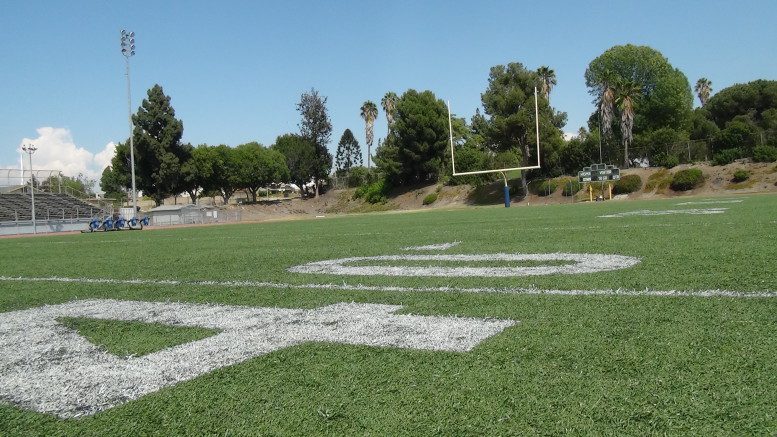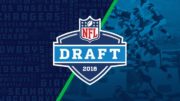The California Department of Public Health is giving high school football programs across the state the go-ahead to return to the gridiron, if the county they are located in has a per-capita case rate of fewer than 14 per 100,000 residents. Friday’s announcement means that practice can begin next Friday, February 26.
Regular weekly testing of high school football coaches and players will be required in counties that have at least seven cases per 100,000 residents.
High school football and other high school sports have been sidelined throughout the coronavirus pandemic.
Below is the complete guidance (reprinted in its entirety) from the California Department of Public Health.
Summary
COVID-19 continues to pose a severe risk to communities and requires all people in California to follow recommended precautions. This guidance provides direction on outdoor and indoor youth and recreational adult sports activities to support a safe environment for these sports. The guidance applies to all organized youth sports and recreation— including school- and community-sponsored programs, and privately-organized clubs and leagues — and adult recreational sports (hereafter youth and adult sports). This guidance does not apply to collegiate or professional sports. Additionally, this guidance does not apply to community events, such as marathons, half-marathons, and endurance races.
Inter-team competitions (i.e., between two teams) resumed in California beginning January 25, 2021. The guidelines outlined in this document shall take effect on February 26, 2021.
The status of return-to-competition is subject to change at any time given the level of COVID-19 transmission in California.
Sports Risk Profiles
In general, the more people from outside their household with whom a person interacts, the closer the physical interaction is, the greater the physical exertion is, and the longer the interaction lasts, the higher the risk that a person with COVID-19 infection may spread it to others.
Youth and adult sports include varied activities that have different levels of risk for transmission of COVID-19. Outdoor activities present significantly lower risk of transmission relative to comparative indoor activities, based on current scientific evidence. Competition between different teams also increases mixing across groups and outside of communities, which also contributes to the potential for spread of COVID-19 disease.
Youth and adult sports are classified below by their level of contact and transmission risk. This classification applies to competition or training/practice with others. It does not apply to individual conditioning or exercise.
The Tables below are not exhaustive, but provide examples of sports with different levels of contact so that the level of risk can be assessed for other sports.
Low-Contact Sports
Individual or small group sports where contact within six feet of other participants can be avoided. Some of these sports have relatively low exertion rates that allow for consistent wearing of face coverings when within six feet of other people.
Moderate-Contact Sports
Team sports that can be played with only incidental or intermittent close contact between participants.
High-Contact Sports
Team sports with frequent or sustained close contact (and in many cases, face-to-face contact) between participants and high probability that respiratory particles will be transmitted between participants.
Factors Affecting the Risk of Transmission
- Risk increases when face coverings are not worn, and physical distancing is not maintained.
- Risk increases with increasing levels of contact between participants; closer contact (particularly face-to-face contact), and the frequency and total duration of close contact, increases the risk that respiratory particles will be transmitted between participants.
- Risk increases with greater exertion levels; greater exertion increases the rate of breathing and the quantity of air that is inhaled and exhaled with every breath.
- Risk increases with mixing of cohorts and groups, particularly when from different communities (during or outside of sports play); mixing with more people increases the risk that an infectious person will be present.
General Guidance for Youth and Adult Sports Participants, Coaches, and Support Staff
It should be noted that local health departments and school districts may have stricter rules and should be consulted to confirm what is allowed.
General Requirements for All Sports:
Irrespective of setting (outdoor or indoor) case rate or sport played, the following general guidance requirements must be adhered to at all times:
- Face coverings to be worn when not participating in the activity (e.g., on the sidelines).
- Face coverings to be worn by coaches, support staff and observers at all times, and in compliance with the CDPH Guidance for the Use of Face Coverings.
- Observers maintain at least 6 feet from non-household members.
- No sharing of drink bottles and other personal items and equipment.
- Mixing with other households prior to and post any practice or competition must strictly adhere to current gathering guidance.
- Limit indoor sports activities (practice, conditioning) to comply with capacity limits (which shall include all athletes, coaches, and observers) indicated in current CDPH Gym & Fitness Center Guidance Capacity.
- Associated indoor activities for the team (e.g., dinners, film study) are prohibited if engaged in competition given evidence that transmission is more likely to occur in these indoor higher risk settings.
- Teams must not participate in out-of-state games and tournaments; several multistate outbreaks have been reported around the nation, including California residents.
Limitations on Observers
- Limit observation of youth sports (age 18 years and under) to immediate household members, and for the strict purpose of age appropriate supervision. This includes observation of practice and competition. Limit number of observers to ensure physical distance can be maintained, reduce potential crowding, and maintain indoor and outdoor capacity limits.
- Consider Video streaming of games so that they can be watched “live” from home
- For adult sports, spectators are not permitted at this time.
Limitations for Inter-Team Competitions and Tournaments
- Inter-team competitions, meets, races, or similar events are permitted to occur only if (a) both teams are located in the same county and the sport is authorized in the Tables below; or (b) teams are located in immediately bordering counties and the sport is authorized in both counties in the Tables below.
- The county-based authorizations outlined in the Table below apply to the locations/counties in which the teams, schools, clubs, leagues, and similar organizations are functionally based (e.g., where the players reside, where facilities are located, etc.).
- Local Health Departments to be notified of any cross county competitions within their jurisdiction and reserve the right under their own discretion to deny the competition at any time in their jurisdiction. Teams participating in cross county competitions will follow the more stringent rules if the participating teams are coming from counties that may be at different case rate thresholds.
- Teams adhere to current CDPH Travel Advisory recommendations when determining travel for competition in neighboring counties.
- No tournaments or events that involve more than two teams to occur. Exceptions may be made, with authorization from the local health department where the event is being held and each of the local health departments where teams originate from, for sports where individual competitors from multiple teams are routine such as: track and field; cross-country; golf; skiing/snowboarding; tennis; swimming/diving/surfing; biking and equestrian events.
- Only one competition, per team, per day maximum to be played.
Permitted Youth and Recreational Adult Sports by Case Rate Threshold
- Physical conditioning, practice, skill-building, and training that can be conducted outdoors, with 6 feet of physical distancing, and within stable cohorts are authorized regardless of case rate or sport. Such activities may be conducted indoors consistent with restrictions by Tier in the Gym & Fitness Center Guidance Capacity.
Other General Guidance
Below are other general guidance that are strongly encouraged as part of any participation in sport. Depending on risk level (high or moderate) and county case rates, these general guidance may be required for play of outdoor sports in less restrictive tiers, as specified below.
Face Coverings
- Face coverings worn by participants during practice, conditioning and during competition, even during heavy exertion as tolerated. See the American Academy of Pediatrics Interim Guidance on Return to Sports [1] for specific exceptions where the face covering may become a hazard.
Physical Distancing
- Maintain at least six feet of distance between sport participants and others to the maximum extent possible, including when on the sidelines.
- Maintain at least 6 feet of distance between coaches and participants and facilitate physical distancing between participants to the maximum extent possible (e.g., staggered starts instead of mass starts for races).
Informed Consent
- Due to the nature and risk of transmission while participating in Outdoor High-Contact and Moderate-Contact sports, provide information regarding risk to all parents/guardians of minors participating in such sports, and have each parent sign an informed consent indicating their understanding and acknowledgement of the risks indicated herein.
Testing
- Unless required as noted below, regular and postseason antigen or PCR testing of sports participants and coaches weekly while participating in Outdoor High-Contact sports is strongly encouraged. If competing, testing performed with test results made available within 24 hours of play.
Hygiene and Equipment Sanitation
- When equipment is shared during an activity, participants perform hand hygiene (wash hands with soap and water or use an alcohol-based hand sanitizer) before play, during breaks, at half time, and after the conclusion of the activity.
- Balls or other objects or equipment can be touched by multiple players during practice and play if the above hand hygiene practices are followed.
Limitations on Mixing by Participants
- Limit participation by athletes and coaches during practice and competition to one team, and refrain from participating with more than one team over the same season or time period. For larger teams, limit mixing by establishing stable smaller training groups for drills and conditioning.
- Review practice or game footage virtually, to the greatest extent possible. If not feasible, then it should be conducted outdoors, with all participants wearing face coverings and following appropriate physical distancing measures.
Indoor Venue Capacity Limitations
- Ventilation in indoor venues (gyms or other fitness centers) increased to the maximum extent possible.
Travel Considerations
- Bus/van travel for members of a team may pose a greater risk. To mitigate COVID-19 transmission risk during bus/van travel, employ universal masking, physical distancing and windows to remain open the full duration of the trip unless not feasible.
- Plan for proper communication of all travel rules, protocols and expectations to everyone in the travel party. When feasible, teams should aim to travel and play the same day to avoid overnight stays.
- Travel by private car limited to only those within the immediate household.
Returning to Sports After Infection
- No one with symptoms of COVID-19 or who is in isolation or quarantine for COVID-19 is permitted to attend practices or competitions.
- Anyone with symptoms of COVID-19 should consult their physician for testing and notify their coach, athletic trainer and/or school administrator of their symptoms and test results.
- Youths recovering from COVID-19 will have different paths to return to sports based on the severity of their illness. See the American Academy of Pediatrics Interim Guidance on Return to Sports [1] for additional guidance for more serious infections.
Vaccination of Eligible Households
- Sports participants, including coaches and support staff, are strongly encouraged to be vaccinated once eligible as vaccines will protect residents and reduce the likelihood of transmission from infected persons to others.
Table: Youth and Adult Recreational Sports* Permitted by Current Tier of County
| Widespread Tier (Purple)1 | Substantial Tier (Red) 2 | Moderate Tier (Orange) 3 | Minimal Tier (Yellow) 4 |
| Outdoor low-contact sportsArcheryBadminton (singles)BikingBocceCorn holeCross countryDance (no contact)Disc golfEquestrian events (including rodeos) that involve only a single rider at a timeFencingGolfIce and roller skating (no contact)Lawn bowlingMartial arts (no contact)Physical training programs (e.g., yoga, Zumba, Tai chi)Pickleball (singles)Rowing/crew (with 1 person)RunningShuffleboardSkeet shootingSkiing and snowboardingSnowshoeingSwimming and divingTennis (singles)Track and fieldWalking and hiking | Outdoor moderate-contact sportsBadminton (doubles)BaseballCheerleadingDodgeball Field hockeyGymnasticsKickballLacrosse (girls/women)Pickleball (doubles)SoftballTennis (doubles)Volleyball | Outdoor high-contact sportsBasketballFootballIce hockeyLacrosse (boys/men)RugbyRowing/crew (with 2 or more people)SoccerWater polo Indoor low-contact sportsBadminton (singles)CurlingDance (no contact)GymnasticsIce skating (individual)Physical trainingPickleball (singles)Swimming and divingTennis (singles)Track and fieldBowling | Indoor moderate-contact sportsBadminton (doubles)CheerleadingDance (intermittent contact)DodgeballKickballPickleball (doubles)RacquetballSquashTennis (doubles)Volleyball Indoor high-contact sportsBasketball BoxingIce hockeyIce skating (pairs)Martial artsRoller derbySoccerWater poloWrestling |
*Play in Less Restrictive Tiers: Outdoor High-Contact Sports
Outdoor high-contact sports (orange tier) can be played in the purple or red tier with an adjusted case rate equal to or less than 14 per 100,000 under the following conditions:
Implement and strictly adhere to the following additional general guidance:
- Informed Consent
- Testing – antigen or PCR (regular and postseason antigen or PCR testing of sports participants and coaches weekly. If competing, testing performed with test results made available within 24 hours of play)
Note: The testing requirement above shall only apply in the following situations:
- For football, rugby and water polo as these are high contact sports that are likely to be played unmasked, with close, face to face contact exceeding 15 minutes.
- When adjusted case rates for the county are between 14-7 per 100,000.
- For sport participants 13 years of age or above as evidence shows that younger children do not seem to be major sources of transmission—either to each other or to adults.
- *If more than 50% of a team’s participants are less than the age of 13 (and are not required to test per the above), then the entire team is exempted from the testing requirement. Coaches, however, will still be required to meet the testing requirement.
Additional general guidance that should be implemented to the greatest extent possible and are strongly encouraged
- Face Coverings (during play)
- Physical Distancing (during play)
- Testing – antigen or PCR
- Hygiene and Sanitation
- Limitations on mixing by participants
- Travel Considerations
*Play in Less Restrictive Tiers: Outdoor Moderate-Contact Sports
Outdoor moderate-contact sports (red tier) can be played in the purple tier with an adjusted case rate equal to or less than 14 per 100,000 under the following conditions:
Implement and strictly adhere to the following additional general guidance:
- Informed Consent
Additional general guidance that should be implemented to the greatest extent possible and are strongly encouraged
- Face Coverings (during play)
- Physical Distancing (during play)
- Hygiene and Sanitation
- Limitations on mixing by participants
- Travel Considerations
If competition for high- and moderate-contact sports is permitted to resume in a county pursuant to this updated guidance, competition is not required to cease if the county’s adjusted case rate exceeds the 14 per 100,000 threshold.








